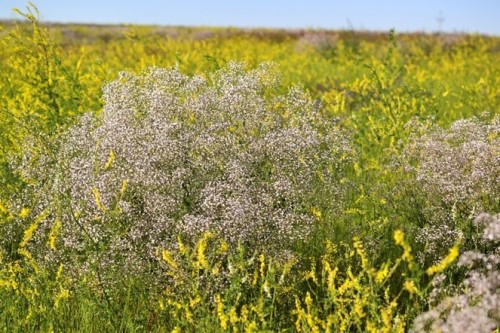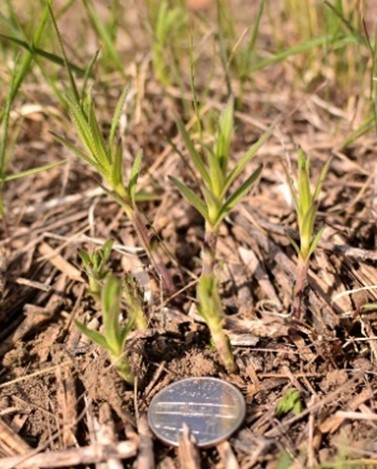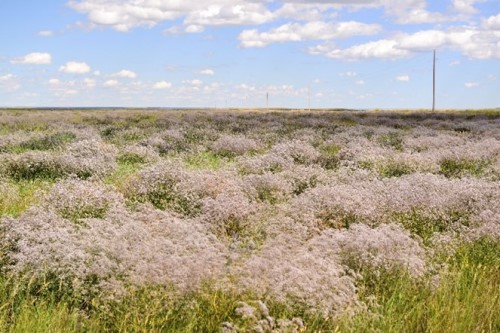Baby's Breath (Gypsophila paniculata)
By Inga Hawbaker, Daniels County Extension, Email Inga Hawbaker
For information regarding plant history, identification, habitat and impact, visit the previous weed post from May 2015.
Biology

Baby's breath in hay field in early July. Photo by Inga Hawbaker.
Baby’s breath reproduction is dependent on seed production, with a single mature plant producing approximately 13,000 seeds annually. A plant becomes reproductive in its third year as it begins flowering and setting seed; seed reaches maturity 4-5 weeks after the first flower buds open. Seed is thought to remain viable in the soil for up to 2 years. Baby’s breath has a thick taproot that can reach depths of 13 feet, aiding in its ability to survive in areas with low rainfall. As plants mature, a woody crown forms with the upper portion of the root, comprising of several stem bases from which shoots develop; the root crown can reach up to 10 inches in diameter in mature plants. While baby’s breath can grow in all soil textures, it appears to grow in coarse textured soils most aggressively; rapid root penetration is exhibited by mature plants as well as seedings.
Management

New baby's breath sprouts in early May. Photo by Inga Hawbaker.
Mechanical, cultural and chemical control methods can be used to control baby’s breath; no form of biological control is available for the species. While having little effect on existing populations, mowing prior to seed set is an effective method for reducing new populations of baby’s breath. Hand pulling can be utilized for young plants but can be difficult as plants mature.
Baby’s breath does not tolerate frequent disturbance so is rarely a problem in annual cropping systems. Deep cultivation has been found to control plants in perennial landscapes, although it is critical that the plant is severed below the crown to decrease the likelihood of plant regeneration; plowing to depths of 6-12 inches may be required. While grazing has been shown to increase populations of baby’s breath, intensive grazing in the early vegetative stage can help reduce seed production and plant vigor. As the plant nears flowering, nutritional value and palatability decreases.
Herbicides with varying modes of action have been utilized in managing baby’s breath. Examples of treatment options include dicamba (e.g. Banvel, Clarity, Opti-DGA) applied after emergence to spring growth or bolting plants. Herbicides that contain metsulfuron methyl (e.g. Escort, Ally, Cimarron, Chaparral) are effective when applied during the bolt to pre-flower growth stage. The success of chemical applications is reduced when plants are in flower as there are few leaves for chemical to adhere to, therefore application timing is important. For additional chemical management options visit Weed Control Handbook from University of California-Davis.

Field infested with baby's breath. Photo by Inga Hawbaker.
Baby’s breath is not on the Montana noxious weed list but is listed on the following county lists: Blaine, Broadwater, Chouteau, Daniels, Deer Lodge, Flathead, Jefferson, Richland, Sheridan, Silver Bow, and Valley. Since 1934 it has been reported in 22 counties in Montana.
Further Information
For more information about this month's weed post, contact Extension Invasive Plant Specialist Jane Mangold. Past posts are available in the Monthly Weed Post Directory.
This weed post is also available as a printable PDF (896KB).
